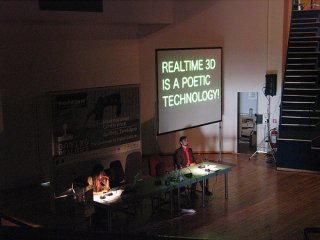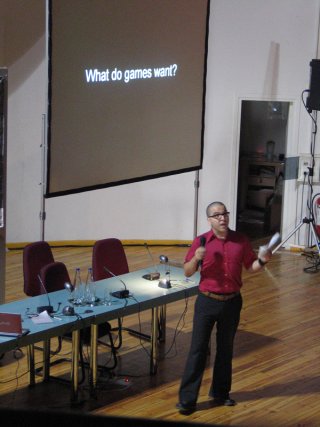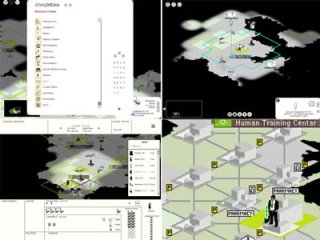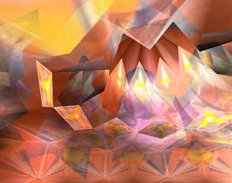Gaming Realities Wrap-up
Date: Monday, October 23 @ 16:27:26 CEST
Topic: Exhibitions
Only
now have I found the time to write this wrap up of what was an
excellent conference and exhibition in Athens: Gaming Realities, the
name given to this year's Mediaterra festival.
The exhibition
itself gave a solid representation of the artistic game development
scene, and was housed in an old gas-works building, converted some years
ago into a venue. The conference programme was full (almost crammed)
with back to back papers and presentations, starting at 10am and riding
through till the early evening. Read on for coverage of what I thought were the highlights.
I was especially impressed by Devin and Jamie's Puppet Show: Intuitive Puppet Interfaces for Expressive Character Control where they presented a vision system they had developed (in Processing)
to enable control of a virtual puppet using no more than a piece of
card folded into a 'glove' covering the fingertips. This made many VR
glove interfaces look like sheer overkill and emphasised the extent to
which even the most basic gestures can enrich suture with a character.
Sadly I can't find a link to this project. If anyone has one, send it
through.
The Ludic Society's
dense treatise looked at a series of interventionist, conceptual and
situational strategies (in the form of projects) for repositioning 'real
life' in the context of play; as a way of tactically reclaiming freedom
of action with ends seemingly similar to those of the Derive project. One work of theirs that clearly expressed this was in the exhibition, and covered in their talk: Ready Played, pixellated documentation of kids in the Banlieues engaging in Parcour,
moving through their local environment in ways it was never built to
support; in one sense, making it their own by finding new ways of being
in it. This 'gamefied' video comes complete with health bar and score
and expressed their broader project, as described in their paper, very
well. It stands as a valuable artefact for reference in any conversation
where game and life might be related, especially with tactical outcomes
in mind. Is play an empowered kind of action - a 'free action' - or
just a way of approaching existing actions? How might the situation of
all action as play change the way we approach living itself? What of our
society do we risk when we bring play into life?
Auriea Harvey & Michael Samyn of Tale of Tales presented their Realtime Manifesto
on Sunday, which stirred up some good conversation. Their talk was
delivered in an especially theatrical fashion, where line by line of the
manifesto was read from each then the other. While speckled with
humour, their manifesto is nonetheless quite serious, asserting ways of
approaching and using realtime 3d technology so that it might be widely
recognised as a powerful, positively influential, context for human
expression. They are decidedly opposed to the avant-garde, frankly
stating it has brought little to enriching human life in general.
Instead they call for a need to use this new medium in ways that are
informed by what they see to be the great contributions of literary and
pictorial traditions made prior to the Rennaissance (if I understood
this correctly). Their manifesto seems especially concerned with lifting
the medium of realtime 3d away from what they see to be myopic artistic
projects of self-referentiality and spiritually unrewarding non
story-driven game-design models, touting it, as the picture below shows,
as a "Poetic Medium".
It was refreshing to be present at the premiere of a manifesto, but
overall I found their push to be one driven by a fear of
diversification, as though the medium itself would somehow fall from
cultural importance through exploration of it's widest possible
applications. It was also overtly concerned with what I see to be a
simplistic, periodic and idealogically grounded construction of what
constitutes 'beauty 'in the context of 'Art'. That said, I thought it
was great to hear someone other than myself and Martin Pichlmair
emphasise the importance of looking at the independence of the medium
itself in any conversation of 'Independent game development'. The Tale
of Tales people understand this very well and stand as a good yet rare
example of putting-your-money-where-your-mouth-is. Despite my
differences with parts of their talk, I always love a manifesto. I'll
post this in the archives soon.

It's only natural that the majority of conversation at an academic game
conference will be grouped around what we can do to make games better. Eric Zimmerman however closed the conference with an interesting inversion by asking:

This I liked, thinking of games as quasi-objects around which we group
action and interest; entities which have lives and needs of their own.
Maybe we should begin to see games not as vehicles for our experiences,
but as systems that once propagated evidence their own desires to
evolve. This is certainly the case with MMO's which while begun with a
seed game design, are often manipulated over the course of time as
play-models and technology prove themselves to be good or bad in the
context of use. The game is also not something exclusively contained in
the media-artifact either, it is expressed through action and so does,
in a sense, 'live' outside the scope of its mere implementation.
Of the artworks on show it was excellent to see the Eastwood Group's Civilization IV
on display. Civ IV is possibly the most ambitious and critically
engaging political game ever made, and also undercover since a copyright
dispute with Sid Meyer himself. Highly recommended playing: the luxury
comes rarely since the copyright dispute.
More here.

Another standout piece was Sylvia Eckermann's Nowhere
currently on show at the 3rd International Digital Art Festival,
Changzhou in China. It was particularly refreshing to see a game engine
(in this case Unreal2004) being used as a 'surface' for the production
of pictorial content. While movement occurs in 3 dimensions, the 'space'
in the work propagates as a sense of moment, rather than anything
perceptibly explicit, moving instead through layered texture elements.
Nice stuff - I'll write about this more when I put it in the archive.

Finally, here's a copy of the paper I gave in my keynote entitled The Game is Not the Medium.
It's available for non-commercial distribution and also features in the
excellent conference proceedings. Hopefully Mediaterra will send me a
link to a site where people can buy it as it's rare to see such a solid
representation of crit theory on games between just two covers.
A big thanks to the Mediaterra crew for a fine festival. Big thnx to
Olli Leino for allowing me to publish the snaps of Eric and Tale of
Tales.
|
|
This article comes from selectparks
|